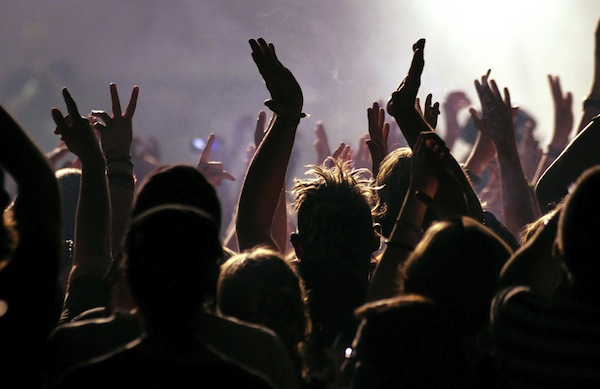
San Francisco concerts have long reflected the music of the times, but the inverse is also true: time and time again, music has revolved around whatever’s going on in San Francisco. This was most apparent in the 1960s, when bands like the Grateful Dead and Jefferson Airplane turned the hippie counterculture into the city’s greatest export. Five decades later, we can look back and identify five concerts that changed American music forever—an inventory of five San Francisco nights that defined San Francisco nightlife.
The Beatles at Candlestick Park
August 29, 1966
Nobody but the Beatles knew that this show at chilly Candlestick Park would be their last live concert performance ever. If it had been announced ahead of time, the Fab Four might have sold the place out. Instead, large swaths of seats were left unsold for the final date of their fourth and final North American tour. It was a strangely low-key farewell for the most popular rock band of all time, who occasionally paused their 11-song set to snap pictures with a camera they had brought on stage. It was the end of an era in many ways, and it paved the way for the decade’s latter half and the Summer of Love, which would take shape in San Francisco less than a year later.
The Human Be-In at Golden Gate Park
January 14, 1967
The Summer of Love actually started with this mid-winter event at Golden Gate Park, just a stone’s throw from the Haight-Ashbury district that would soon become synonymous with the counterculture. Inspired by sit-ins taking place at lunch counters, colleges, and universities across the country during the early 1960s, the Human Be-In was perhaps the first focused expression of the hippie movement. California had recently passed a law banning LSD, and everyone from poet Allen Ginsberg to psychologist Timothy Leary showed up to encourage a crowd of thousands to “turn on, tune in, drop out.” Of course, no celebration of hippiedom would be complete without bands like the Grateful Dead and Jefferson Airplane, both of whom found their way onto the bill.
Aretha Franklin at Fillmore West
March 5–7, 1971
Though people tend to associate San Francisco with the hippie counterculture, the city has long been a haven for jazz and soul. From Jelly Roll Morton to John Coltrane, musicians would flock to play the clubs on Fillmore Street, and their hundreds of legendary concerts exist now only in memory. This is not the case with Aretha Franklin’s three-night set at Fillmore West, which eventually became one of the best live albums of its era. The Queen of Soul dove right in with her hit song “Respect,” but she filled out her set with such hippie standbys as the Beatles’ “Eleanor Rigby” and Simon and Garfunkel’s “Bridge Over Troubled Water.” In doing so, she bridged the gap between the counterculture and modern American soul in a way that few singers had ever attempted.
The Band at Winterland Ballroom
November 25, 1976
Another concert that’s been immortalized for new generations to enjoy, the Band’s farewell show at Winterland Ballroom is considered one of the greatest concerts, period. Martin Scorsese's documentary film The Last Waltz captured the Band in all their fading glory, but they weren’t the only ones to take the stage that night. Bob Dylan, Neil Young, Joni Mitchell, the Staples Singers, and Van Morrison were among the special guests on hand, making this arguably the most star-studded affair in San Francisco’s history.
Metallica at The Stone
March 5, 1983
Who knew that the future of heavy metal would be born on a spring night in San Francisco? Metallica had already made a name for themselves as thrashers whose live show took no prisoners, but this date at The Stone felt different. For starters, it was their first show with new bassist Cliff Burton, who would eventually go down as the greatest metal bassist of all time. It was a prelude of what was to come later that summer on Kill 'Em All, one of the fastest and heaviest albums in history. And—like many of the best moments in American music history—it all started on a sweaty stage in San Francisco.






